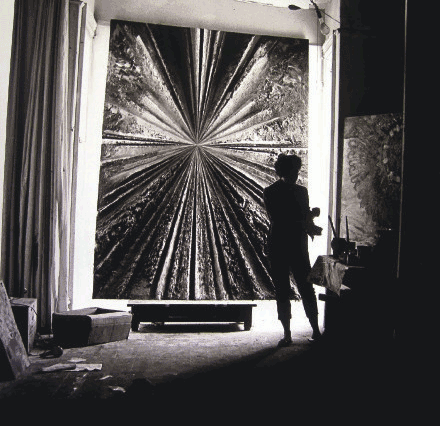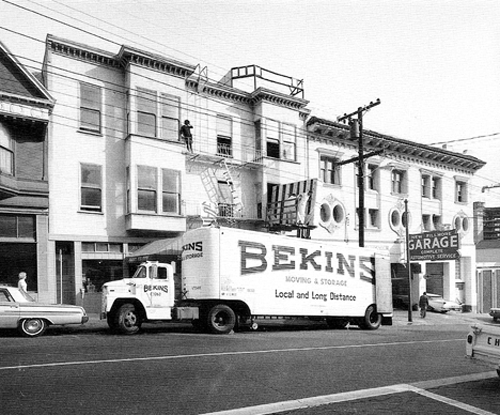
Photograph of Jay DeFeo working on The Rose by Jerry Burchard
ART | JEROME TARSHIS
Youthful aspiration, ambivalence toward conventional art world success and a pitifully low budget came together for Bruce Conner and Jay DeFeo in the history of her masterpiece, The Rose.
DeFeo worked on it for eight years in her Fillmore apartment, building up layer upon layer of paint to a thickness of eight inches. By the time she stopped working on it, in 1965, it weighed a ton and its future was compromised by the fact that its paint was so heavy that the painting was pulling itself apart.
Looking back, Conner said that DeFeo’s potentially endless reworking of The Rose needed “an uncontrolled event to make it stop.” The Pasadena Art Museum had asked to exhibit the painting, but DeFeo put off letting it go. The eviction of Hedrick and DeFeo from 2322 Fillmore provided the nudge; it was necessary to move The Rose somewhere, and circumstances dictated Pasadena.
On November 9, 1965, a crew from Bekins Van and Storage removed The Rose through an opening sawed into the front wall of DeFeo’s studio and lowered it to a moving van. That was not the end of what came to seem an obsessive effort; DeFeo worked on the painting for three more months in Pasadena before curator Walter Hopps could persuade her that she had done enough.
Conner filmed the painting’s departure from Fillmore Street, exposing 700 feet of film over a period of two days. In 1967 he released the seven-minute final version, with a sound track from Miles Davis’s “Sketches of Spain.” Its title was “The White Rose: Jay DeFeo’s Painting Removed by Angelic Hosts.” In their white coveralls the movers seemed to radiate light, much as the painting itself seemed to do.
Conner’s involvement did not stop with the film. Although the painting was an art world legend, and in 1959 any of a number of American museums would have loved to acquire it, by 1967 both DeFeo and The Rose had fallen off the radar.
Conner appointed himself DeFeo’s “manager” and over a period of more than 20 years participated, with other DeFeo admirers, in an often frustrating effort to find a museum that would acquire the painting and pay for the needed restoration. Until that happened, The Rose remained entombed in plaster behind a wall at the San Francisco Art Institute. DeFeo died in 1989, at the age of 60, her death arguably hastened by the unremitting work, heavy drinking and intense exposure to paint fumes that went into the creation of The Rose.
In 1995 the Whitney Museum of American Art in New York signed an agreement to acquire the painting if it could be successfully stabilized. The following year The Rose was exhibited for the first time since 1969. It has since taken its place as a viewable artwork rather than a hidden-away object of legend.
Thomas Hoving, former director of the Metropolitan Museum of Art in New York, included The Rose in his book Greatest Works of Art of Western Civilization. He describes it as “perhaps the single most expressive painting of the 1960s, and one of the most expressive statements in the entire last third of the 20th century.”
During the many years The Rose lay hidden from view, Conner’s beautiful, elegiac film was the only form in which this masterpiece of American painting could be seen by the public.
It remains a tribute to the friendship between two artists — and to a time when Fillmore Street was a center of avant-garde creativity.
Filed under: Art & Design






